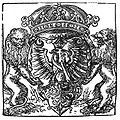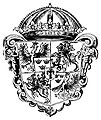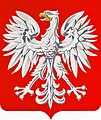User:Kpalion/Coat of arms of Poland
Infobox
[edit]| Orzeł Biały (White Eagle) | |
|---|---|
 | |
| Adopted | 1295; last modified in 1990 |
| Shield | In a red field, a white eagle with a golden crown, beak and talons |
| Use | National coat of arms of the Republic of Poland |
Lead
[edit]The White Eagle (Polish: Orzeł Biały) is the national coat of arms of Poland. It is a stylized white eagle with a golden beak and talons, and wearing a golden crown, in a red shield.
Design
[edit]Legal sources
[edit]The coat of arms of the Republic of Poland are described in two legal documents: the Constitution of the Republic of Poland of 1997,[1] and the Coat of Arms, Colors and Anthem of the Republic of Poland, and State Seals Act (Ustawa o godle, barwach i hymnie Rzeczypospolitej Polskiej oraz o pieczęciach państwowych) of 1980 with subsequent amendments[2] (henceforth referred to as "the Coat of Arms Act").
Legislation concerning the national symbols is far from perfect. The Coat of Arms Act has been amended several times and refers extensively to executive ordinances, some of which have never been issued. Moreover, the Act contains errors, omissions and inconsistencies which make the law confusing, open to various interpretations and often not followed in practice.[3]
Elements of the coat of arms
[edit]According to Chapter I, Article 28, paragraph 1 of the Constitution, the coat of arms of Poland is an image of a crowned white eagle in a red field.[1] The Coat of Arms Act, Article 4, further specifies that the crown, as well as the eagle's beak and talons, are golden. The eagle's wings are outstretched (displayed) and its head is turned to its right.[2] Using English heraldic terminology, the arms may blazoned as Gules an Eagle Argent crowned, beaked and armed Or. However, unlike in traditional heraldry where the same blazon may be rendered into various graphical designs, the Coat of Arms Act allows only one official rendering of the national coat of arms. The official design may be found in attachment no. 1 to the Coat of Arms Act.[2]
The nearly circular charge, i.e. the image of the white eagle, is highly stylized. The heraldic bird is depicted with its wings and legs outstretched, its head turned to the right, in a pose know in heraldry as displayed. The eagle's plumage, as well as tongue and leg scales are white with gradient shading suggestive of a bas-relief. On each wing there is curved strap going from the bird's torso along the upper edge of each wing and terminated with a five-pointed mullet (star). Each mullet has three larger and two smaller arms. The beak and talons are the only golden parts of the eagle's body. The crown on the eagle's head consists of a base and three fleurons extending from it. The base is adorned with three rougly rectangular gemstones. The fleurons – of which the two outer ones are only partly visible – have the shape of a fleur-de-lis. The entire crown, including the gems, as well as spaces between the fleurons, is painted gold.
The charge is placed in an escutcheon (shield) of the Modern French type. It is a nearly rectangular upright isosceles trapezoid, rounded at the bottom, whose upper base is slightly longer than the lower one, from the middle of which extends downwards a pointed tip. Although the shield is part of the coat of arms, Polish law stipulates, in certain cases, to only use the charge without the escutcheon. The shades of the principal tinctures, white (Argent) and red (Gules), which are the national colors of Poland, are specified as coördinated in the CIE 1976 color space (see Flag of Poland – National colors for details).
Structure
[edit]- Lead
- Design
- Use
- Seals
- Signs
- Documents
- Coins and notes
- History
- Origins
- Legend of Lech, Imperial eagles, Arms of the Piasts
- Changing styles
- Elements of the coat of arms: shield, eagle, cloverstalks, crown, royal initials, crest
- Gothic, Renaissance, Baroque, Classicist styles
- The Eagle and the Pursuer
- Lesser, Medium and Greater Arms of the PLC; Arms of the elecetive kings; Order of the White Eagle
- Time of Partitions
- Arms imposed by foreign powers: Duchy of Warsaw, Grand Duchy of Posen, Congress Kingdom
- Development of military eagles
- Popular designs: November, Krakow, January Uprisings
- Towards the current design
- 1916 and 1919 designs
- 1927 design by Kamiński
- Crownless Eagle
- Democratic and socialist traditions since mid-19th cent., the "Kurica", arms of the People's Rep. of Poland
- Recent changes
- Restoration of the crown, modified mullets on the wings
- Origins
- Related and similar symbols
Gallery
[edit]1. Gothic Eagle of King Premislaus, ca. 1295
2. Gothic Eagle of King Ladislaus I, ca. 1320
3. Gothic Eagle of King Casimir III, ca. 1335
4. Late Gothic Eagle of King Ladislaus II, ca. 1434
5. Renaissance Eagle with King Sigismund I's initial "S", ca. 1533
6. Renaissance Eagle with King Stephens's initial "S", ca. 1588
7. Baroque arms of King Sigismund III, 1611
8. Classicist Eagle of King Stanislaus Augustus, 1771
9. Eagle from former King Stanislaus I's brochure, 1749
10. Arms of the Duchy of Warsaw, 1806
11. Arms of the "Congress" Kingdom of Poland, 1815
12. Arms used during the January Uprising, 1863
13. Arms of the Republic of Poland, 1919
14. New design, 1927
15. Communist crownless Eagle, 1980
16. Current design, 1990]]
1
[edit]-
Premislaus
-
Ladislaus I
-
Casimir III
-
Ladislaus II
-
Sigismund I
-
Sigismund II
-
PLC
-
Stephen
-
Sigismund III
-
Stanislaus I
-
Stanislaus II
-
Varsovie
-
Posen
-
Царство Польское (©?)
-
November Uprising
-
Cracow Uprising
-
January Uprising
-
Russian CoA
-
1919
-
1927
-
1944
-
1980
-
Gov't-in-exile
-
1990
2
[edit]-
Lech
-
Boleslaus I
-
Probus
-
Premislaus
-
Ladislaus I
-
Casimir III
-
Toison d'Or
-
Alexander
-
Sigismund I
-
Ladislaus IV
-
John II's base for the crown
-
Pendant from a royal casket
-
Stanislaus II (SAR)
-
SAR ceremonial sword
-
SAR throne
-
Order of the White Eagle
-
10 mkp, 1916
-
Kościuszko Division
Legislation
[edit]| Date | Title | Document type | Journal | Link |
|---|---|---|---|---|
| 1919-08-01 | Ustawa z dnia 1 sierpnia 1919 r. o godłach i barwach Rzeczypospolitej Polskiej | Act of Parliament | Dz.U. 1919 nr 69 poz. 416 | |
| 1927-12-13 | Rozporządzenie Prezydenta Rzeczypospolitej z dnia 13 grudnia 1927 r. o godłach i barwach państwowych oraz o oznakach, chorągwiach i pieczęciach | Presidential ordinance | Dz.U. 1927 nr 115 poz. 980 | |
| 1930-11-24 | Rozporządzenie Prezydenta Rzeczypospolitej z dnia 24 listopada 1930 r. w sprawie zmiany rozporządzenia Prezydenta Rzeczypospolitej z dnia 13 grudnia 1927 r. o godłach i barwach państwowych oraz o oznakach, chorągwiach i pieczęciach | Presidential ordinance amending a presidential ordinance | Dz.U. 1930 nr 80 poz. 629 | |
| 1933-03-14 | Ustawa z dnia 14 marca 1933 r. w sprawie zmiany rozporządzenia Prezydenta Rzeczypospolitej z dnia 13 grudnia 1927 r. o godłach i barwach państwowych oraz o oznakach, chorągwiach i pieczęciach | Act of Parliament amending a presidential ordinance | Dz.U. 1933 nr 29 poz. 246 | |
| 1937-03-03 | Ustawa z dnia 3 marca 1937 r. w sprawie zmiany rozporządzenia Prezydenta Rzeczypospolitej z dnia 13 grudnia 1927 r. o godłach i barwach państwowych oraz o oznakach, chorągwiach i pieczęciach | Act of Parliament amending a presidential ordinance | Dz.U. 1937 nr 17 poz. 111 | |
| 1955-12-07 | Dekret z dnia 7 grudnia 1955 r. o godle i barwach Polskiej Rzeczypospolitej Ludowej oraz o pieczęciach państwowych | Decree of the Council of State | Dz.U. 1955 nr 47 poz. 314 | [1] (typo corrected by [2]) |
| 1955-12-07 | Rozporządzenie Rady Ministrów z dnia 7 grudnia 1955 r. w sprawie tablic i pieczęci urzędowych | Ordinance of the Council of Ministers | Dz.U. 1955 nr 47 poz. 316 | [3] |
| 1957-02-01 | Dekret z dnia 1 lutego 1957 r. w sprawie zmiany dekretu o godle i barwach Polskiej Rzeczypospolitej Ludowej oraz o pieczęciach państwowych | Decree of the Council of State amending a decree of the Council of State | Dz.U. 1957 nr 10 poz. 42 | [4] |
| 1980-01-31 | Ustawa z dnia 31 stycznia 1980 r. o godle, barwach i hymnie Rzeczypospolitej Polskiej | Act of Parliament | Dz.U. 1980 nr 7 poz. 18 | [5] |
| 1989-12-29 | Ustawa z dnia 29 grudnia 1989 r. o zmianie Konstytucji Polskiej Rzeczypospoliej Ludowej | Act of Parliament amending the Constitution | Dz.U. Nr 75, poz. 444 | [6] |
| 1990-02-09 | Ustawa z dnia 9 lutego 1990 r. o zmianie przepisów o godle, barwach i hymnie Rzeczypospolitej Polskiej | Act of Parliament amending an act of Parliament | Dz.U. 1990 nr 10 poz. 60 | [7] |
| 2004-02-20 | Ustawa z dnia 20 lutego 2004 r. o zmianie ustawy o godle, barwach i hymnie Rzeczypospolitej Polskiej | Act of Parliament amending an act of Parliament | Dz.U. 2004 nr 49 poz. 467 | [8] |
| 2005-07-28 | Ustawa z dnia 28 lipca 2005 r. o zmianie ustawy o godle, barwach i hymnie Rzeczypospolitej Polskiej | Act of Parliament amending an act of Parliament | Dz.U. 2005 nr 172 poz. 1439 | [9] |
- ^ a b (in Polish) Konstytucja Rzeczypospolitej Polskiej [(in English) Constitution of the Republic of Poland], Dz.U. 1997 nr 78 poz. 483
- ^ a b c (in Polish) Ustawa o godle, barwach i hymnie Rzeczypospolitej Polskiej oraz o pieczęciach państwowych [Coat of Arms, Colors and Anthem of the Republic of Poland, and State Seals Act], Dz.U. 1980 nr 7 poz. 18
- ^ (in Polish) Informacja o wynikach kontroli używania symboli państwowych przez organy administracji publicznej (PDF), Warsaw: Supreme Chamber of Control (NIK), 2005






































